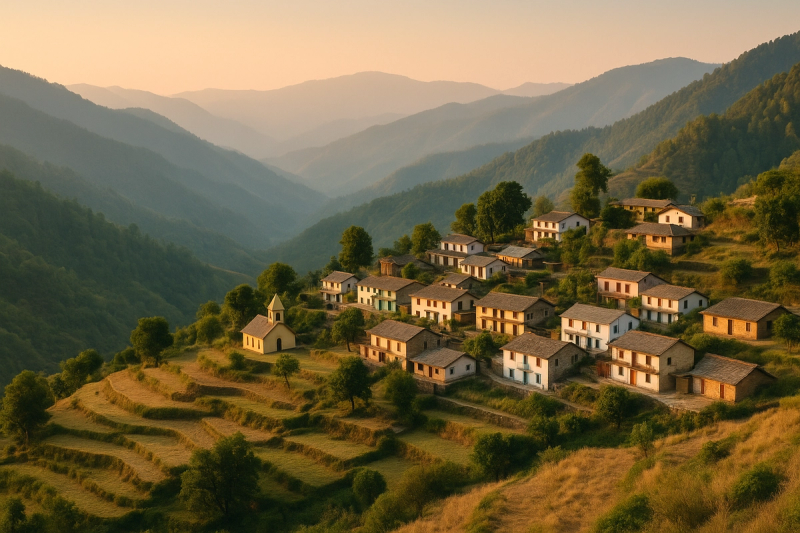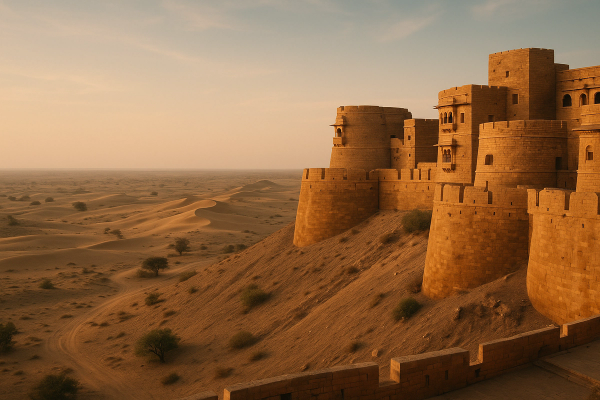7 Hidden Villages in Uttarakhand for Offbeat Travel (From Someone Who Actually Went)#
I keep going back to Uttarakhand for the same reason I visit my nani’s place — it feels like home, but you always find something new around the bend. This time I skipped the usual Nainital–Mussoorie loop and chased seven quiet, ridiculously pretty villages where life moves on pahadi time. Fewer selfies, more sky. Less noise, more bird calls. And a lot of chai with strangers who become, you know, friends.¶
Why offbeat Uttarakhand, and what’s the scene right now#
Quick update before the stories. Roads are mostly fine outside monsoon, but widening work and occasional slips do cause delays on the Char Dham stretches — start early, avoid night driving. Forest fires can flare up in April–May, so check local news or the UKSDMA/IMD alerts if you’re heading into pine belts. Jio works in most valleys now, Airtel is decent in towns, BSNL is that stubborn uncle who shows up when everyone else disappears. UPI is accepted in surprising places as of 2025, but still carry cash for shared jeeps, chai stalls, and homestays. And honestly, keep plans flexible — the mountains aren’t in a hurry, neither should we be.¶
1) Khirsu, Pauri Garhwal#
Khirsu is that kind of village where your morning begins with Chaukhamba staring back at you like a shiny postcard. Pine and deodar everywhere, terrace farms, and a breeze that smells like rain even when it’s not raining. I stayed at a simple homestay near the GMVN — nothing fancy, just warm rooms, hot food, and views that make you forget your phone. Expect 1500–2500 INR per room per night for clean stays; homestays usually do 700–1200 per person for meals. Best months: Oct–Nov for razor sharp views, Mar–Apr for blossoms. Getting there: Rishikesh/Dehradun to Srinagar Garhwal buses, then shared jeeps to Pauri and onward to Khirsu. Don’t miss aloo ke gutke with bhang ki chutney at a small dhaba near the meadow. I may have asked for second helpings twice.¶
2) Peora, near Mukteshwar (Kumaon)#
Peora is slow travel heaven — an eco-village wrapped in orchards, walking trails that smell of oak and rhododendron, and homestays that care about the land. I joined a family for their evening chai, watched them sort walnuts, and walked through old stone-paved paths where even the dogs seem relaxed. Stays range 1800–3500 INR per room depending on how fancy you want it, with simple local meals: mandua roti, bhatt ki churkani, jhangora kheer. From Haldwani or Kathgodam, catch a shared jeep to Almora or Mukteshwar side, then hop off for Peora. Pro tip: carry a light fleece even in April evenings — Kumaon nights can surprise you.¶
3) Sari, base for Deoriatal (Rudraprayag)#
Sari isn’t exactly a secret, but stay a night and it becomes lovely again. I reached by sunset, and the village just glowed — wheat fields, little homestays, kids chasing a football on the road. Next morning, I hiked an easy 1.5–2 hours up to Deoriatal and watched Chaukhamba paint itself into the lake. If you want that mirror-calm reflection, go early and pray for no wind. Homestays in Sari are very budget-friendly — 1000–1800 INR for rooms, add on 400–600 for meals. Nearest big hub is Ukhimath; shared jeeps are frequent in season. Avoid peak monsoon for the trail, and carry your trash back. Locals are patient with visitors, let’s return the respect.¶
4) Barsu, gateway to Dayara Bugyal (Uttarkashi)#
Barsu is where I first met the high meadows. Dayara Bugyal is a gentle climb and then boom — a green ocean. In late spring it’s all flowers and in winter it’s a snow field that feels endless. The GMVN in Barsu is old-school and solid, and there are a few homestays that serve mountain dal with ghee in a way that tastes like childhood. Typical costs: 1500–3000 INR per room for guesthouses; homestays 1200–2000 per person including meals. Keep an eye out for the Anduri Utsav (Butter Festival) around August in the region — locals celebrate the pastoral life with color and laughter. Getting there: Dehradun–Uttarkashi bus, then shared jeep to Bhatwari–Barsu. Start hikes early, weather flips post noon.¶
5) Kalap, Upper Tons (Uttarkashi side)#
Kalap is the one that made me rethink what a holiday means. No roads to the village — you trek 8–10 km from the roadhead, cross wooden bridges, and suddenly you’re in a world that looks a hundred years old in the best way. Traditional wooden homes, terraced fields like stairs to the sky, and a community that runs tourism with pride. Signal is patchy to none, power is sometimes solar, and the stars… I just sat outside for an hour doing nothing. Book through the community-run outfit (search Kalap Trust) since that keeps money local. Budget 2000–3500 INR per person per day with guided walks and meals. Be mindful of dress, noise, and photos — ask first, always. Also, pack light and carry a rain cover even on clear days.¶
6) Sarmoli, near Munsiyari (Kumaon)#
Sarmoli is for people who like to wake up with Panchachuli glowing pink. The village has one of the best community homestay networks I’ve seen — women-led, thoughtful, and deeply rooted. I joined a dawn bird walk and then spent half a day in a weaving unit learning how many hands a shawl passes through. If you time it right, you might catch local fairs and cultural events in summer, and the whole village seems to be out smiling. Stays range from 1500–2500 INR per person with meals depending on the house and season. Getting here is a ride — Haldwani/Kathgodam to Almora–Baijnath–Thal–Munsiyari by bus or shared sumo, then a short hop to Sarmoli. Totally worth every zigzag.¶
7) Kanak Chauri, ridge to Kartik Swami Temple (Rudraprayag)#
Chopta gets crowded, but Kanak Chauri is still that quiet ridge where the sky feels very near. The walk to Kartik Swami Temple is short, and sunrise there is honestly outrageous — a 360-degree sweep of peaks, the kind that makes everyone whisper without knowing why. There are basic homestays and a couple of lodges around the trail start; think 1000–2000 INR rooms, home-style meals you’ll probably remember on the bus back. Best time: Oct–Dec for skies, Mar–Apr for rhododendron. Roads are winding but in decent shape outside monsoon — I took a shared jeep from Rudraprayag and it was bumpy, but hey, mountain seats are character building.¶
Getting around, seasons, money, food — the real stuff#
- Best weather windows: Mar–Apr for blossoms and cool days; Oct–Nov for crystal views. Winter is magical above 2000 m but plan for frozen pipes and short days. Jul–Sep is lush, also landslide season — keep buffer days.
- Transport: Buses from Dehradun/Haldwani/Kathgodam are reliable, but slow. Shared jeeps (Sumo/Bolero) connect the last miles — fares 80–400 INR depending on distance. If you self-drive, start early, refuel often, and skip night drives.
- Connectivity and cash: Jio works in most of Kumaon–Garhwal towns, drops in remote valleys. Carry some cash (2–4k) for jeeps and village shops even if UPI is common. Download offline maps. Power backups are not guaranteed, bring a power bank.
- Food to hunt down: aloo ke gutke with bhang ki chutney, mandua ki roti with ghee, bhatt ki churkani, gahat (kulthi) dal, kafuli in Garhwal, and buransh sharbat in spring. Ask for local seasonal veggies — pahadi pahari taste hits different.
- Safety basics: Check IMD/UKSDMA advisories in monsoon, and local police/forest updates for trail closures. In spring, be careful with cigarettes and campfires — pine needles burn fast. Tell your host your plan if you head out early.
Rough trip math for a 5–6 day offbeat loop (per person)#
Very ballpark, but this is what I usually spend: Delhi–Kathgodam/Dehradun bus or train 600–1200; local buses and jeeps across 5–6 days 1000–2500; homestays 1500–2500 per person per night with some meals included; food and chai 500–800 per day if meals aren’t bundled; permits and tiny things 200–600. Total comes to roughly 10–20k depending on how many places you try to cram in and how fancy your bed is. Slow travel brings this down. Rushing pushes it up.¶
Final thoughts, before the mountains close the door again#
Each of these villages gave me something small and priceless — a shortcut across fields in Khirsu, a walnut-stained hand in Peora, a sunrise that stole my words in Sari, the hush of Dayara in Barsu, a night sky in Kalap I can still see when I shut my eyes, a woven story in Sarmoli, and wind-bells at Kartik Swami that sounded like a blessing. If you go, go gently. Stay where the money stays in the village. Carry your waste back. Learn two phrases of the local tongue, it changes everything. And if you want more detailed routes and stay leads, I keep notes over at AllBlogs.in — it’s where I plan and where I daydream between trips.¶














